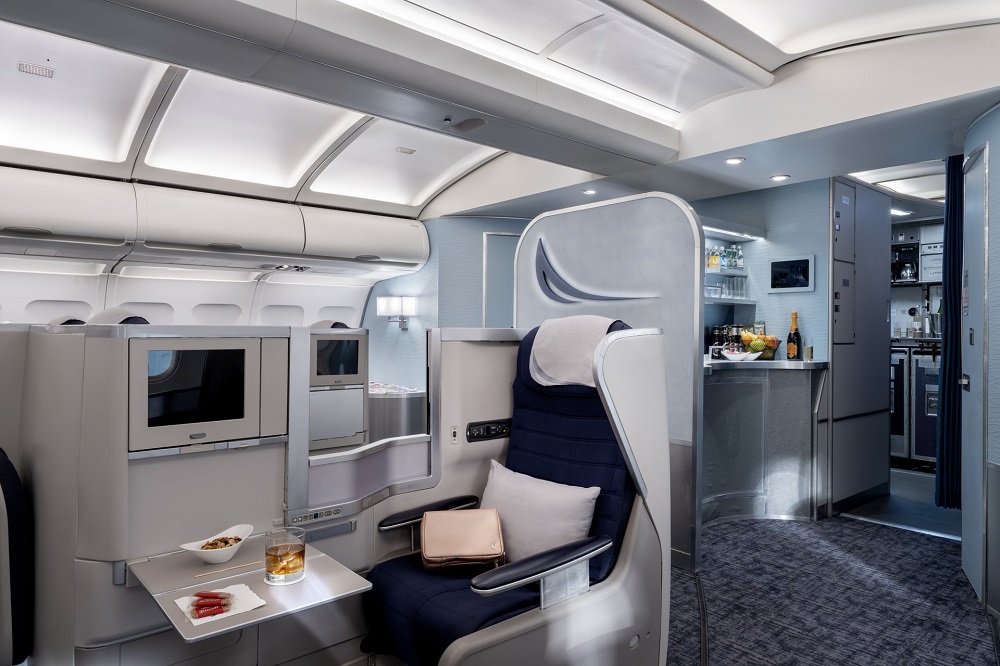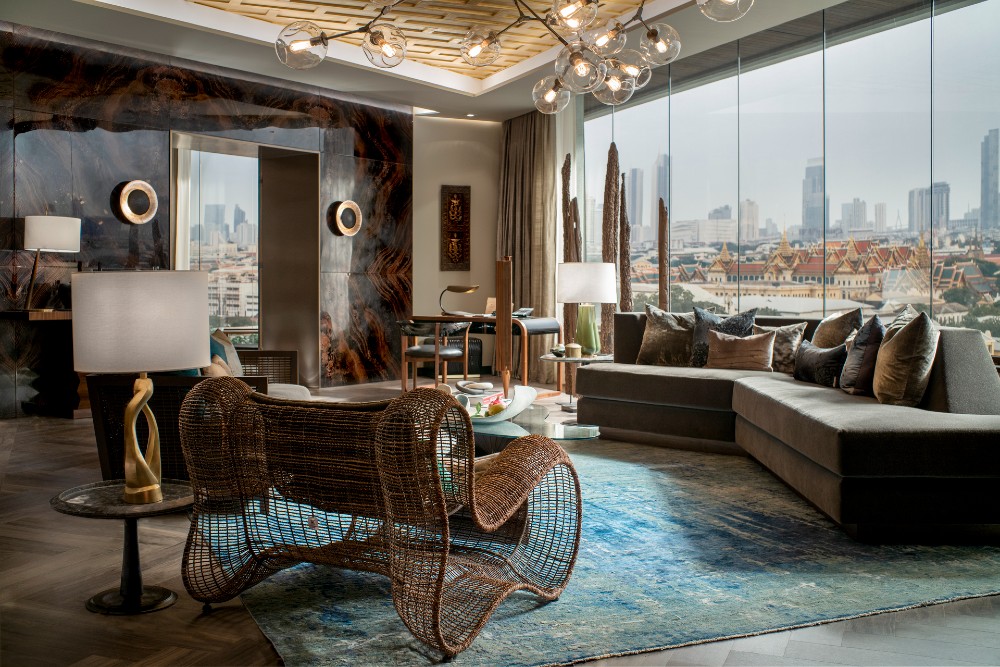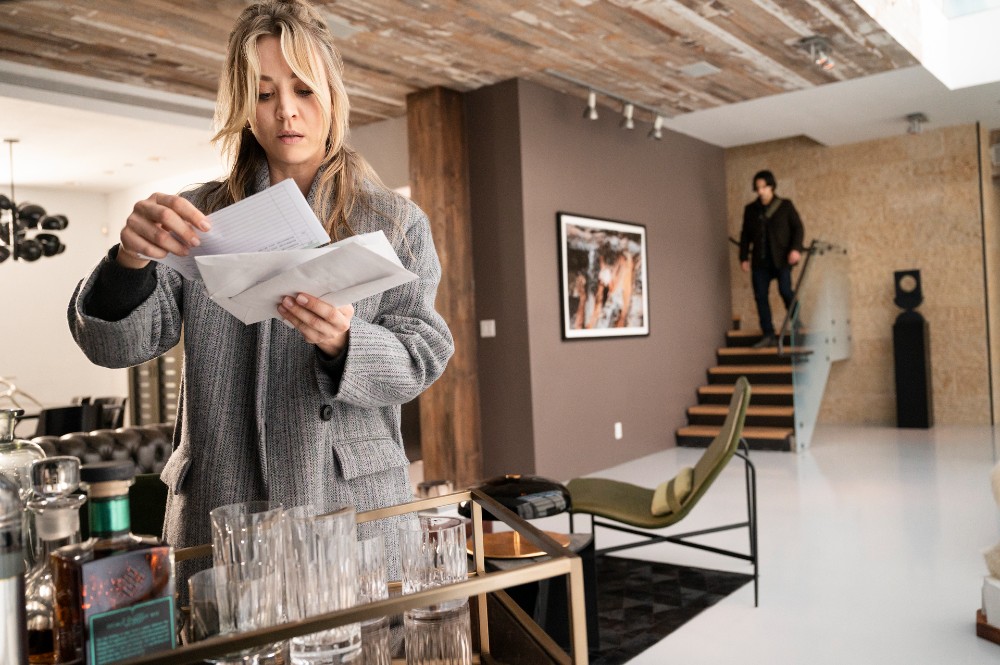
“It’s been such an honor to receive the nomination,” enthuses Sara K White, who earned her first-ever Emmy nomination in the Outstanding Production Design For A Narrative Contemporary Program (One Hour Or More) category for her work on The Flight Attendant. “I happened to be back home in Ohio when I got the news, and it was really special to celebrate with my family and longtime friends who have known me my whole life. I know my parents and my partner, Neil, who have been with me during this decade-long journey, are so thrilled to see the good news.”
The nomination – shared with art director Christine Foley and set decorator Jessica Petruccelli — is well-deserved. Gorgeous, sleek and fizzy, HBO Max’s The Flight Attendant was exciting visually as it was story-wise, with White’s sets serving as characters in their own right. Her previous credits include several indie features, among them Obvious Child, Stand Clear of the Closing Doors, A Kid Like Jake, Tallulah, and Bushwick, as well as the series Mrs. Fletcher, and The Wilds (with The Flight Attendant Director Susanna Fogel), the commercial campaigns for Kodak, Sprite and Delta, and music videos for Beach House and The Mountain Goats.
Below the Line recently caught up with White for a wide-ranging conversation in which she discussed that crazy shower, her background, whether or not she’ll be involved in the second season of The Flight Attendant, and which set from the show she could live in if she had to.
Below the Line: Let’s start with Annie’s shower. Is that your personal dream shower? And how amazed are you with the way that shower captured the attention and imaginations of so many people?
Sara K White: It is most assuredly not my dream shower. I’m a bit more modest than Annie! I did love creating it, though, and I’m so glad that it was received as the showstopper it was designed to be. It needed to introduce Annie’s character very powerfully and create a moment of shock for Cassie – and the audience – so making that goal come to fruition was such a treat. I do have a secret hope that exposed showers start to trend out there in the world. Given how the public/private division has been crumbling during Covid, I think we have a shot.
BTL: In many shows and movies, sets are sets; they’re where the action occurs. And in many cases, they reflect the personalities of various characters. But in The Flight Attendant, the sets did both of those things AND also reflected the state of mind of the main character… who can’t really remember a lot of what’s happened to her. What kinds of opportunities and challenges did that present for you?
White: For me, I’m constantly intrigued by the way spaces are designed to convey information to its occupants. There’s a function, yes, but it’s human nature to communicate things like power or comfort or excitement with design, be it in a bedroom, a courtroom or a club. I love that subconscious transference of information, and in this project, I was able to explore that with the intention of exposing her subconscious environment, which was great fun. I thought about how humans deal with trauma and built a language for it in design, but staying on top of all those details was a challenge. Luckily, I had a fantastic team that was willing to explore with me. Christine Foley and Jessica Petruccelli took these ideas and ran.
BTL: You get a script. You confer with the director, and then what’s your process from there?
White: At the beginning of a project, there are so many pieces you’re setting up. I’m meeting with the director and showrunners to talk about the intention of every major set-piece, the emotional tone we’re trying to convey to the audience, how we’re shooting, blocking, scoring. I’m researching to find the right mix of inspiration and authenticity for each of the spaces. And I’m bringing on my crew so we can start designing and experimenting. With that in place, I start sketching, often by hand, on the bigger sets, which gives me the freedom to find shapes and spatial sequences. Once I have a strong direction, I’ll bring it to the director and showrunners to confirm the concept and talk it through with the DP to make sure shot and framing needs are in sync. Then I take it back to my team to get rolling on a digital model, drafting for construction and selecting finishes and furnishings. From the moment I have a script to the moment they shoot it, I’m constantly checking in with my team and my collaborators to make sure we are on the same page about where we’re headed, so that when we get there, we’re all happy to invite the actors on to set and let them make the story real. It’s a lot of moving pieces, but it’s invigorating.
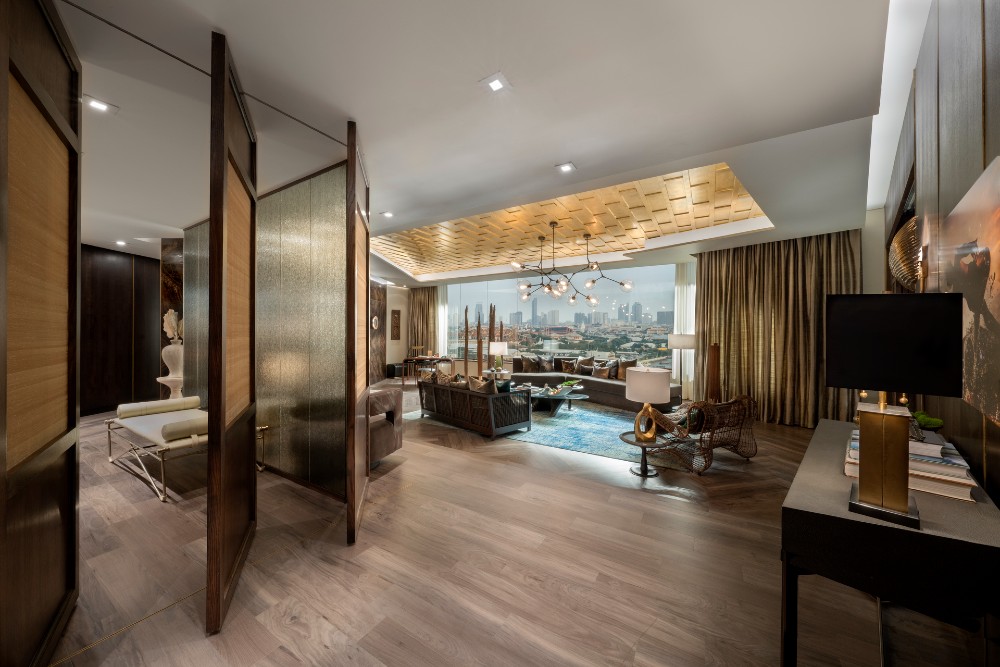
BTL: I’m going to throw out the names of several key Flight Attendant sets. Please break down for me how you brought each one to life. Starting with the Makara Prince Hotel suite.
White: This was our marque set, so it took the majority of our attention from the start. I was inspired by the idea of shattering – that Cassie’s reality, everything she knows and the structure on which she’s built, her life shatters when she sees Alex beside her covered in blood. She has to constantly reexamine what happened that night and the stories she’s told herself about her own past. I took those ideas into the floor plan, by giving us a circuitous pathway through the set and moving doors and panels to hide and reveal spaces and play with symmetry. Bringing reflection, refraction and obfuscation into the finishes gave our DPs a bunch of opportunities to re-envision the space which is important because we’re in there so much.
It was also critical to evoke location with the details and décor – a sensuous hotel for the 1% in Bangkok, a literal world away from Cassie’s apartment. If the audience wasn’t wowed with Cassie when she entered, and wasn’t pulled into a darkly masculine vibe that she could ascribe to Alex’s personality, I didn’t think it would work. Imagine the space with bright white surfaces or soft fluffy linens! It wouldn’t have taken us to emotional spaces that could carry this particular mystery. Once we had a direction, it was all about elevating every surface and every furnishing to make it special, which my team did beautifully.
BTL: Cassie’s apartment?
White: Cassie’s apartment was a location with some pretty specific goals. First, we wanted the blocking to allow Cassie to be continuously in motion when we first enter her apartment, so we mimicked the racetrack layout of the hotel room. We also wanted it to be small enough to be believable, but nice enough to get the sense that Cassie maybe pulled out her charm to secure the lease. We kept the décor a little youthful, a little half-completed, so you could get the sense that while she knows how to give the appearance of things looking nice, she doesn’t really have herself together yet.
BTL: Alex’s Apartment?
White: The script placed this apartment down by the Vessel in the Hudson Yards area of New York – very new and very monied. We knew we needed a location for this set, so our location manager found a unique penthouse nearby that had great bones but was mostly white. We needed to add a dark and unnerving layer to make Cassie question the love affair she’s been creating for herself. We brought down the tone of the walls and brought in a mix of antiques, to reflect his childhood home, and masculine modern furniture that could be a little risqué. That plus eye-catching art that made her question his relationship to women. A huge cache of Playboys, and one poor stuffed polar bear cub gave Cassie the jolt she needed to reconnect her with what was really happening – she was being tailed by a few nefarious groups and needed to keep one step ahead.
BTL: And the Sokolov Mansion?
White: This one was also a location, and we looked high and low for something that gave us the icy traditional elegance Janet Sokolov exuded. We amplified the cool blue tones that were already in the home and redressed spaces like the sunroom (which was a gym) and Janet’s office (originally a bedroom) to let Cassie sneak through the mazing hallways in the house. It’s the first time that she can’t talk herself out of a situation, and Annie has to save her. We wanted to make Cassie feel outclassed, outgunned, out of her element and entirely at the mercy of the Sokolov family empire.
BTL: Annie’s loft…
White: From the outset, I played with the ideas of public and private space and drew from Annie’s job as a lawyer who finds it empowering and exhilarating to walk the knife’s edge between odious and illegal Per the first scripted beat in the apartment, Annie’s loft was anchored by that shower. We needed a real attention-grabbing moment, and it worked! From there, we thought a lot about how a newly wealthy, powerful young woman could be both bold and soft in the space; she’s sophisticated but brash. Compared to her office, there’s a sensitivity here, a softness to the palette and lines, to show what she hides from the world. We also loved bringing in bold new art from living female artists to complement the character arc. Jane Dell and Crys Yin had great pieces for us to incorporate.
BTL: Imperial Atlantic’s planes…
White: Our glamorous airplane was a complete Frankenstein. In order to get the plane up, we had to venture to the UK to find the base elements – our set pods, wall panels and the galley all came from ShootAviation, but had been harvested from different planes. Building flourishes like our help-yourself champagne bar helped bridge the gap between the mid-sized elements and added details that gave the space the high-end elegance we needed. Planes are never easy to shoot in, so we widened out aisles and added removable elements and camera ports wherever we could to keep the work inside the plane manageable. I really enjoyed working with my graphics and visual effects teams to round out the look of the airline, too. Creating a comprehensive branding package, from the napkins to painting the plane, let me dig into every detail.
BTL: What kind of shorthand did you form with Susanna Fogel while working on The Wilds? And how did that carry over to The Flight Attendant?
White: From the very beginning we felt like we could trust each other with our ideas, no matter how outlandish. We don’t have a filter when we share ideas, so we could bring anything to each other and feel confident that we would be heard even if we moved away from it in the end. Our references built on each other and pushed each other further, really filling out the lives we were creating on screen. It’s an invigorating way to collaborate.
BTL: What did Christine Foley and Jessica Petruccelli bring to the table for you?
White: I could not have asked for better partners on this show. Christine and Jessica are smart, talented and driven women. Both saw the vision for the project with me and were on board to expand on it. Christine’s experience with construction and specialty fabrication brought to life details like the hand-carved lotus screens in the Makara Prince that she oversaw with her teams. And Jessica and her team went in deep on the characters, making sure that the smallest details came through, down to the scratches on the tables in our dive bar. Without such a strong team, so many of these ideas would have been lost.
BTL: Who else on your team do you want to recognize?
White: So many people! I want to give special shout-outs to my Thai and Italian teams who came on for short periods of time, but offered so much in rounding out the show’s authenticity and chic glamour. My prop masters, Courtney Schmidt and Jeff Mazzola, my graphics team, led by Max Bode, my construction and scenic teams, everyone from top to bottom on this show really brought it. I’m so proud and thankful.
BTL: In what ways did Covid-19 change the game for you and the entire Flight Attendant production unit?
White: We shuttered our production on day two of the sixth episode with only a couple weeks left in our filming schedule. It was incredibly lucky that we had just completed our final international piece in Rome, and we were really barreling toward the end. With March 13th down, we thought we were getting a chance to catch our breath before we plunged back in, but of course, it was over before months later when we picked back up and we had to reconsider so much. Scripts were reconceived to limit locations and crowd scenes, and shooting on stage with maximum control for our cast and crew was prioritized. We snagged another stage and filled it with a number of sets to keep us as contained as possible. Some were just a corner of a bedroom, but others were quite sizable, such as the hospital and bar locations that rounded out episode six, which had to come together quickly. Designing for safety meant keeping ceilings off, creating touchless entry points into the sets, and spending hours sanitizing the sets and props. It was a huge benefit for us to have created a trusting shorthand with the team before the pandemic, so we could work through all the Zoom presentations, remote approvals, and pod and zone restrictions. It was about keeping that standard of quality to the end, which I’m so proud to say we did.
BTL: Let’s jet back in time. You studied interior design and poetry. What did you love about those disciplines, and what did you want to be when you grew up?
White: There were always many different things I thought I wanted to be when I was a kid. I wanted to train horses, design shoes, furniture, be an astrophysicist, an architect, a writer. When I got to college, I settled on interior design because I loved thinking about how to make the spaces we’re in better, but architecture seemed less connected to the tactile human experience. I wanted to get closer to the everyday business of being alive and be a part of affecting experiences through the physical environment.
Writing was always a hobby for me. I wrote little stories and poems growing up, as so many kids do, with some cringe-worthy teen poem output. But as I studied and grew with it, what I loved in the wordplay, the internal structures, and the condensed storytelling was the emotional communication happening between the writer and the reader. Distilling a moment or a lifetime into a few short phrases and still being able to share and affect others profoundly, it’s a powerful art.
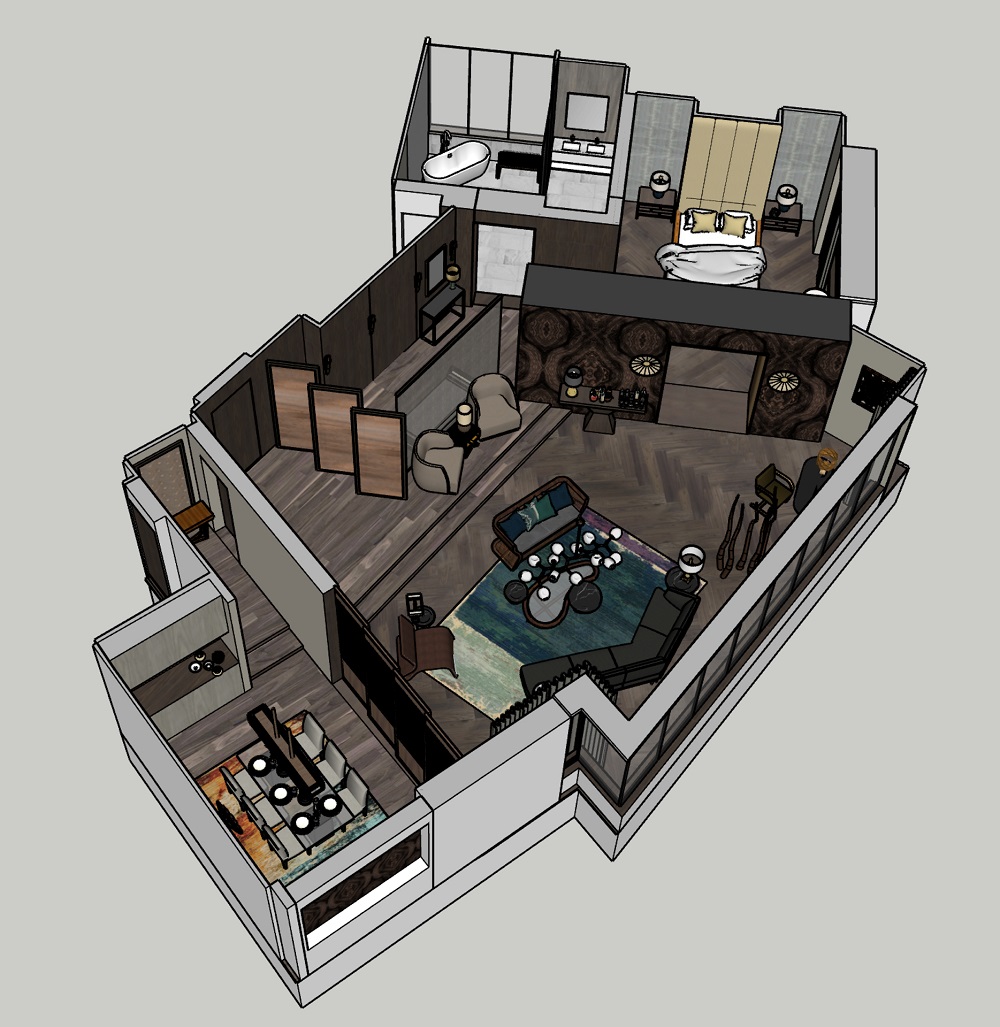
BTL: What led you to films and TV production design?
White: I moved to New York right after college graduation and went to work at a corporate architecture firm, which I loved at first. I wanted to help improve the work lives of people; it’s where you spend so much of your waking life. But the nuts and bolts of working as a designer meant I didn’t have much connection with the users of those spaces, and I couldn’t connect with them to consider the small details of their day. I spent a lot more time thinking about printer alcoves and coordinating duct placement. Also important, but less exciting. And I found my work, corporate or residential, only affected a small segment of the population, which felt limiting.
When a group of friends who had recently graduated from NYU’s film program started needing free help on their first films, I jumped in and was so inspired by the medium. I loved creating spaces informed by a variety of human experiences and invited fantasy and magic to be front and center. I immediately started scheming to change careers. When the Great Recession hit, I asked to be laid off with the others from my firm, and while I questioned my sanity at the time, it seems like it’s working out now!
BTL: In what ways does working as a production designer satisfy those initial interests in interior design and poetry?
White: Poetry taught me to take a big idea and find elements that will connect to an audience, to make those precious. In every script, we’re taking big themes, big stories, and bringing them down to a runtime that makes sense. So, finding what’s precious is critical. And I love that I get to do that for all kinds of characters and people with this work. Interpreting the space and telling the story of someone who is living on the edges of society while raising an autistic kid like in Stand Clear of the Closing Doors; that was something I never could have done in my past career. Or making a glamorous hotel for the inside of someone’s mind; not sure I could have found that client. With production design, I get to take the best of both of those worlds and expand them. It’s incredibly fulfilling.
BTL: You’ve amassed more than 30 credits in the past decade. What three or four of those projects would you cite as the best/most educational/most career-forwarding experiences?
White: The project that hooked me was a teeny music video I designed for Michael Leviton’s song, “Summer’s the Worst,” a ukulele-heavy love shanty. We had no money, so we created our sets… a 1940s-inspired crusty old sailor’s bar and a mermaid’s underwater lair, using forced-perspective miniatures. From working out the math with our cinematographer to hot-gluing shells to our paper mâché cove, it was an incredibly immersive experience. And I knew then that I would leave my office gig as soon as I could. My first art directing job on the film Pariah was a great step for me. I was able to work under the talented eye of my friend, production designer, Inbal Weinberg. That project helped me understand the scope and opportunities that filmmaking offered to every member of a crew; we were all in it together telling a story, finding happy surprises and working hard to make our tiny budget stretch. I was so moved by the crew family we made on that show. Many of us have remained close ever since.
Learning television production on HBO’s Mrs. Fletcher was also a game-changer. TV is a beast all its own, with a pace that doesn’t quit. But the collaborative style is so engaging in that it let me dig even deeper into the stories and characters. I love staying with them longer to really support their growth and character arcs. Tom Perrotta and Helen Estabrook, along with so many talented directors on that show, taught me a great deal. But truly, each project I’ve worked on has been important in bringing me to The Flight Attendant, and I’m looking forward to taking all these experiences and moving into what’s next.
BTL: Season two of The Flight Attendant won’t be next. Why not?
White: Unfortunately, due to family and personal reasons, I was unable to join season two in its move to L.A. I’m so sad to miss out on continuing the journey with them, but I know they’re making an incredible show.
BTL: If you were going to live for a year in one of the sets you devised for The Flight Attendant, which one would you choose – and why that one?
White: I think it would have to be the Makara Prince. As much as I love every inch of Annie’s, at the end of the day, I’ll choose a soak in a tub over a shower every time!
The entirety of The Flight Attendant Season 1 can be watched streaming on HBO Max. All images courtesy WarnerMedia unless otherwise specified.

